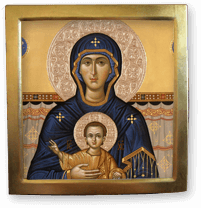Travel Guides - First to Go Back
by Irina Skariatina
An Aristocrat in Soviet Russia
by Irina Skariatina (Mrs. Victor F. Blakeslee)
Formerly Countess Irina Wladimirovna Keller
Indianapolis, The Bobbs-Merrill Company 1933
pages 42-46
From the cour d'honneur we entered the palace, and having checked our galoshes and the famous bread and sausage, put on enormous felt slippers and started on our tour. Going upstairs we first visited the blue and gold church situated in the left wing of the palace and then passed through the seemingly endless chain of rooms that runs through the entire length of the building. Blue rooms, white rooms, yellow, green and red, halls for the nobility, halls for the Guardsmen, halls for the diplomats, they stretched ahead of us, gorgeous, gilded, cold, uncomfortable. Past the main staircase we went to the Silver Hall and into the great Throne Room, on and on through series of reception-rooms until we all got weary of them and felt that we had seen enough. However, the famous Amber Room renewed our interest and we lingered in the Room of Lapis Lazuli and in the lovely empire apartments of the Emperor Alexander I. And everywhere we went we saw large groups of workers and peasants listening attentively to their guides who were carefully explaining every detail of the palace from both an historical and an architectural point of view. I too listened to them as much as I could and heard their interpretations of the role that monarchy had played in Russian history when everything, they said, had been given to the ruling classes and nothing left for the peasant. And though this theme was minutely developed, again I did not hear any of the "bloody expressions" of the days of Red Terror, but the guides referred to the monarchs simply as Catherine II or Nicholas II.
But at last our long walk through the Catherine Palace was finished, and having shed our felt slippers and picked up our galoshes, and the bread and sausage which was becoming a nuisance, we walked across to the Alexander Park that surrounds the Alexander Palace. Built by the famous architect Quarenghi for Catherine's grandson, Alexander I, this palace is as simple as the great palace is rich. It was used by the last Emperor as his residence. One wing, where Nicholas II and his family lived, is now a museum; the other is a rest-house for workers.
Again with a strange mixture of feelings I went in, trying to walk as slowly as possible and lagging behind the others. Many times had I been in this palace at presentations to the last Empress, and during the revolutionary summer of 1917 I had seen the doomed Emperor forlornly digging in the garden, sometimes helped by his daughters. It was like visiting a house of the dead haunted by ghosts.
Coming into the small entrance hall with the marble busts of the children of the Emperor Nicholas I on the mantelpiece, we passed through the so-called Felix Faure Room, filled with pictures and souvenirs connected with the last Emperor's and Empress's journey to France in the 'nineties, and came to the little home church where their chairs stood just as they used to, behind a screen with panels of dark blue glass.
Then we came into the white-and-cream-colored marble ballroom, where once as a young girl I had disgraced myself at a presentation by laughing outright when a stout old lady in front of me curtsied low to the Empress, and as she did so her tight satin skirt, fastened with snappers, suddenly burst open with a bang right in the middle of her seat. And I had laughed and laughed and my mother had scolded me and threatened to punish me with no effect whatsoever as I couldn't stop laughing.
Suddenly the custodian's voice awoke me from my dreams. "Here," she was saying, "is the screen behind which always stood an armed soldier in case the Emperor or Empress needed him. And over there on those chairs by the door leading into the park they sat and waited for Kerensky all night long to take them to the train that was to carry them into exile in Siberia. That door is historical for through it the Romanovs left Russia for ever."
Silently we gazed at the chairs, at the door, and silently left the room.
In the next hall I found the large picture representing the Emperor Nicholas I on horseback with my greatgrandfather, Field-Marshal Prince Paskevich, at his side.
"Hello, Great-Grandfather," I whispered and, going up to the picture, touched the tip of his boot.
"Visitors are requested not to touch anything with their dirty hands," said another custodian, severely, glaring at me disapprovingly, and apologizing for my misdemeanor, I hurried after the others who were already far ahead.
Then we came into the room where stood the children's wooden slide and Alexei's toys and also the Empress's court dresses on wire frames. And already the dresses looked faded and old.
On and on we went through the libraries and dining-room into the Empress's formal drawing-room where she used to receive. It gave me a shock to see the chairs grouped just the way they used to be during presentations and as I stood and gazed at them I could see her in the succession of different colored gowns that she had worn on those occasions. On the wall hung her famous full-sized portrait by Kaulbach as well as the tapestry representing Marie Antoinette, in a red dress, with her children.
"A strange thing for Alexandra to have in her room considering the fate of the French Queen" remarked Vic. We went on through the passage and into the Emperor's first study, where hung another beautiful portrait of the Empress and also a pair of pictures, representing, the guide said, a meeting between Peter the Great, tall as a giant, and the tiny boy-king of France, Louis XV, dressed in a pale blue suit. In the first picture, the two crowned heads are seen bowing low to each other. In the second, Peter is carrying the small boy over the threshold, as, according to etiquette, both kings were supposed to enter a room at the same time.
In the Emperor's second private study everything was just as he had left it; his writing desk, literally covered with family photographs and even his old calendar still showing the date of his departure to Siberia; his large Turkish tahta, or divan, alongside the wall and his son's little table and chair where Alexei used to sit and play.
Passing through the bathroom the custodian pointed to a huge marble tub, saying: "And this was Nicholas's swimming pool where the water was always dyed pink or blue so as to make it look as attractive as possible. However, as the water used to be changed only once a week and the whole family bathed in it, it certainly was never too clean"- an anecdote that seemed hard to believe.
"I think that man is embroidering, and made up that story," I whispered to Vic, who as usual answered in a loud voice: "Hush!"
In the Emperor's third and last study, decorated so as to look like the salon of a ship, on the billiard table still lay the maps of the war with little flags stuck all over them.
"Up there," the custodian continued, pointing to a wooden gallery in a corner of the room, "Alexandra used to sit unseen and listen to Nicholas's conversations with his ministers. And when things didn't go the way she wanted, she would write little notes and send them down to him."
Then we came to the Empress's rooms, famous for their deplorable lack of taste: her hideous "modern art" (Art Nouveau) drawing room her parlor with a large picture of the Annunciation and many photographs and souvenirs of her girlhood in Darmstadt, her mauve boudoir where she used to spend so much time on her couch, and finally her bedroom with the narrow, twin, brass bedsteads standing in an alcove where on the main wall hung a multitude of icons. Sad rooms, full of sad memories, I felt like an intruder in them -just as I had felt when I read the Letters of the Empress to the Emperor - and it was with a sigh of relief that I left that palace.
Please send your comments on this page and the Time Machine to boba@pallasweb.com





 Imperial Bedroom
Imperial Bedroom Portrait Hall
Portrait Hall Mauve Room
Mauve Room Maple Room
Maple Room Aleksey's Bedroom
Aleksey's Bedroom Nicholas's Study
Nicholas's Study Aleksey's Playroom
Aleksey's Playroom Formal Reception
Formal Reception Balcony View
Balcony View Aleksey- Balcony
Aleksey- Balcony Children-Mauve
Children-Mauve Nicholas's Bathroom
Nicholas's Bathroom Alexandra- Mauve
Alexandra- Mauve Nicholas's Reception
Nicholas's Reception Tsarskoe Selo Map
Tsarskoe Selo Map